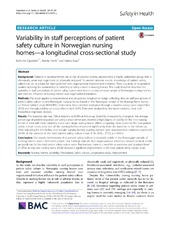| dc.contributor.author | Cappelen, Kathrine | |
| dc.contributor.author | Harris, Anette | |
| dc.contributor.author | Aase, Karina | |
| dc.date.accessioned | 2019-05-22T11:23:26Z | |
| dc.date.available | 2019-05-22T11:23:26Z | |
| dc.date.issued | 2018-09-18 | |
| dc.Published | Cappelen K, Harris A, Aase K. Variability in staff perceptions of patient safety culture in Norwegian nursing homes — a longitudinal cross-sectional study. Safety in health. 2018;4:9 | eng |
| dc.identifier.issn | 2056-5917 | |
| dc.identifier.uri | https://hdl.handle.net/1956/19688 | |
| dc.description.abstract | Background Patients in nursing homes are at risk of adverse events, representing a highly vulnerable group that is chronically weak and cognitively or physically reduced. To prevent adverse events, knowledge of patient safety culture can act as a basis for nursing homes’ own organizational improvement initiatives. There is scarcity of longitudinal studies exploring the sustainability or variability of safety culture in nursing homes. This study therefore describes the variability in staff perceptions of patient safety culture over time in a cross-sectional sample of Norwegian nursing homes, and tests the influence of nursing homes’ own organizational initiatives. Methods The study applied a cross-sectional and prospective longitudinal design collecting data on staff perceptions of patient safety culture in nine Norwegian nursing homes based on the Norwegian version of the Nursing Home Survey on Patient Safety Culture (NHSOPSC) instrument. Data collection took place through a baseline survey (June–September 2013) and through a follow-up survey (March–April 2015). Data were analyzed by descriptive statistics, t-test, and hierarchical regression analysis. Results The response rate was 70% at baseline and 69% at follow-up. Variability, measured by changes in the average percentage of positive responses per safety culture dimension, showed a high degree of stability for the nine nursing homes in total with more variability across each single nursing home. When comparing mean scores for the total patient safety culture score, only one of the nursing homes improved significantly from the baseline to the follow-up. After adjusting for the facility level (single nursing home), nursing homes’ own organizational initiatives explained 29.5% of the variance in the total patient safety culture score (F [4, 263] = 27.53, p < 0.001). Conclusion Our results demonstrate that patient safety culture is relatively stable in the Norwegian sample of nursing homes over a 20-month period. Our findings indicate that organizational initiatives tailored to local needs are predictors for the total patient safety culture score. Furthermore, there is a need for an extensive and sustained level of effort as only one nursing home (NH6) showed a significant improvement in the total patient safety culture score. | en_US |
| dc.language.iso | eng | eng |
| dc.publisher | BioMed Central | eng |
| dc.rights | Attribution CC BY | eng |
| dc.rights.uri | http://creativecommons.org/licenses/by/4.0 | eng |
| dc.subject | Nursing homes | eng |
| dc.subject | Variability | eng |
| dc.subject | Perceptions | eng |
| dc.subject | Safety culture | eng |
| dc.subject | Longitudinal study | eng |
| dc.subject | Improvement | eng |
| dc.title | Variability in staff perceptions of patientsafety culture in Norwegian nursinghomes — a longitudinal cross-sectional study | eng |
| dc.type | Peer reviewed | |
| dc.type | Journal article | |
| dc.date.updated | 2019-02-14T09:48:06Z | |
| dc.description.version | publishedVersion | |
| dc.rights.holder | Copyright 2018 The Author(s) | eng |
| dc.identifier.doi | https://doi.org/10.1186/s40886-018-0076-y | |
| dc.identifier.cristin | 1665551 | |
| dc.source.journal | Safety in health | |
| dc.relation.project | SHARE - Centre for Resilience in Healthcare: 5091 | |

